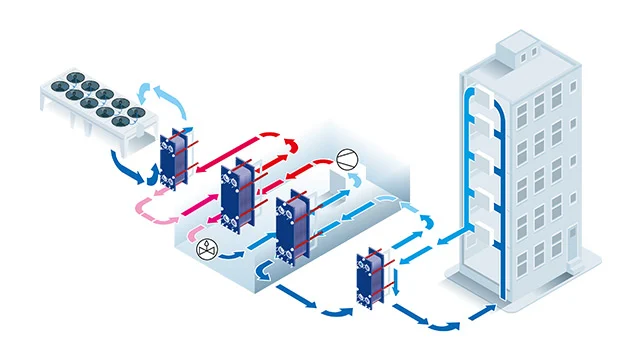Introduction
As urban populations grow and temperatures rise, cities face increasing demand for efficient and sustainable cooling solutions. District cooling systems, which provide centralized cooling to multiple buildings, are gaining traction as a way to meet this demand. Among the most energy-efficient and eco-friendly methods being integrated into these systems is evaporative cooling. By harnessing the natural process of evaporation to lower temperatures, evaporative cooling minimizes energy use, reduces greenhouse gas emissions, and alleviates strain on power grids. This technology is not only transforming how cities manage cooling but also setting a foundation for greener, more resilient urban infrastructure in the face of climate change.
How It Works: Evaporative cooling uses the natural process of water evaporation to lower air temperatures, which in turn cools the water circulated through district cooling systems. By absorbing heat from the air, water droplets evaporate, cooling the remaining water, which is then distributed to provide chilled air to connected buildings.
Improved Urban Air Quality
- Evaporative cooling helps reduce urban heat island effects by lowering ambient temperatures in densely populated areas, leading to better air quality and reduced reliance on traditional air conditioners that can emit heat and pollutants.
Lower Operational Costs for Cities
- The reduced energy consumption of evaporative cooling translates to lower operational costs over time, making it an economically sustainable solution for city-wide cooling, especially as energy costs fluctuate.
Increased Cooling Capacity
- Evaporative cooling enhances the capacity of district cooling systems by boosting cooling output without requiring additional energy-intensive equipment, allowing for effective cooling in expanding urban centers.
Enhanced Energy Efficiency Ratings
- Cities implementing evaporative cooling in district systems can improve their overall energy efficiency ratings, contributing to national and international sustainability benchmarks and targets.
Integration with Renewable Energy Sources
- Evaporative cooling systems can be effectively combined with renewable energy sources, like solar power, to further decrease dependency on the electrical grid and support cities’ clean energy goals.
Scalability for Different Climate Zones
- While especially effective in hot, dry climates, modern evaporative cooling technologies can be adapted to varying humidity levels, making them versatile for different climate zones and adaptable to changing weather patterns.
Reduces Strain on Electrical Grids
- By relying less on electrically powered chillers, evaporative cooling decreases peak electricity demand during the hottest months, helping prevent blackouts and reducing stress on the urban power infrastructure.
Potential for Heat Recovery
- District cooling systems using evaporative cooling can also be paired with heat recovery technologies, allowing cities to repurpose waste heat from industrial processes or power plants, further boosting energy efficiency.
Supports Sustainable Building Certifications
- Buildings serviced by district cooling with evaporative methods may qualify for green certifications, like LEED, by meeting criteria for energy efficiency, water usage, and reduced greenhouse gas emissions.
Decreased Noise Pollution
- Compared to mechanical chillers, evaporative cooling systems tend to operate more quietly, helping reduce noise pollution in urban environments, which is beneficial for residential areas and urban centers.
Reduces Refrigerant Use and Environmental Impact
- Evaporative cooling minimizes the need for refrigerants, which are often potent greenhouse gases, thereby reducing the environmental impact associated with refrigerant leakage or disposal.
Conclusion
Evaporative cooling is transforming district cooling systems into more sustainable and efficient urban infrastructure solutions. By utilizing the natural cooling power of evaporation, cities can reduce energy consumption, lower operational costs, and minimize environmental impact—all while providing reliable cooling to dense urban areas. This approach not only supports city-wide energy efficiency and resilience but also enhances urban air quality, reduces noise, and conserves water when paired with advanced recycling methods. As cities continue to grow and face climate challenges, integrating evaporative cooling into district systems offers a viable path to sustainable urban cooling, helping cities become healthier, more attractive, and climate-adapted places to live and work.

